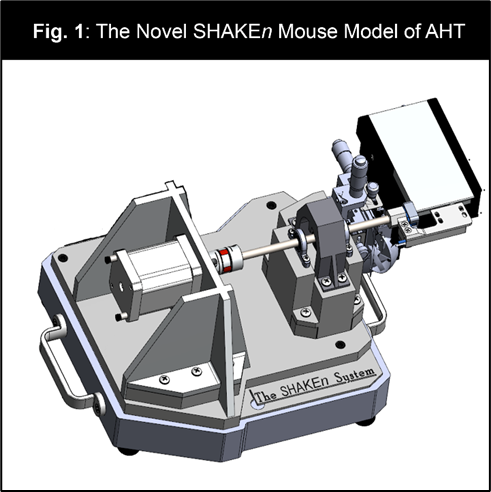Advantages:
- User control to adjust the positioning of the body plate (in the x/y plane) to optimize spinal alignment relative to the axis of rotation prior to insult.
- An aeronautics-grade angular rate sensor for direct measurement of angular velocity and to calculate rotational acceleration of the head.
- An electric plug to power accelerations and to simplify laboratory installation (i.e. avoids compressed gas tanks used in other rodent head injury models).
- Circuitry/PC software to easily impute injury parameters and to record sine wave data on angular acceleration.
- The use of an ultra-high torque motor to allow biaxial rotational acceleration-deceleration injury (↨RADi) in both the extension and flexion directions.
Summary:
There is an unmet need for commercially available laboratory equipment that facilitates the study of the mechanical forces that cause rotational acceleration-deceleration injury (RADi) to the brain in small animals. And there is need for experimental brain injury models that facilitate the recording of “common data elements” (CDEs). Which refers to the critical details about an experiment (i.e., the brain insult parameters) that allow for replication studies to be done. And CDEs promote cross study comparisons of datasets obtained at different times and/or places in different research laboratories. The SHAKEn™ device is under development to address these commercial gaps in the preclinical brain injury research space. Robust control over the rotational insult parameters and tools to record them will provide highly rigorous and reproducible data in small animal studies of RADi mediated brain injury. And will help to expedite elucidation of secondary brain injury mechanisms that may be modifiable with therapies. As well as a robust system to test the therapeutic efficacy of novel or repurposed treatments.
Potential Research Application:
- Abusive Head Trauma/“Shaken Baby Syndrome”
- Abusive Adult Trauma/“Shaken Adult Syndrome”
- Abusive Elderly Trauma/”Shaken Elderly Syndrome”
- Sports-Related Head Injury
- Neonatal Abstinence Syndrome (NAS) with Associated Head Trauma
- Neonatal opioid withdrawal syndrome (NOWS) with Associated Head Trauma
- Other scenarios with the possibility of rotational brain injury (e.g., aviation, automotive accidents associated with whiplash)
- Therapeutic Testing & Drug Development (e.g., Neuroprotective Agents)
- Disease Etiology/Mechanisms of Secondary Brain Injury

The majority of the design work is complete. The chassis has been fabricated. And a commercially available motor has been selected and validated. And can induce peak angular accelerations of the head stage (in its current design form) to the target maximum of 50,000 rad/s2 (Fig. 1) The remaining work to be done involves software development. And is needed to integrate and control all hardware components within a single PC graphical user interface. And for recording insult parameter permutations and data output on velocity/acceleration waveforms.
Desired Partnerships:
- License
- Sponsored Research
- Co-Development